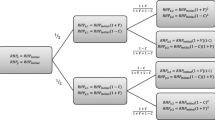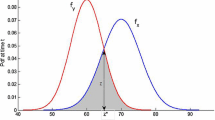Abstract
The persistence of linear dominance hierarchies is often attributed to higher probabilities of a win after a win or a loss after a loss in agonistic interactions, yet there has been no theory on the evolution of such prior-experience effects. Here an analytic model, based on the idea that contests are determined by subjective perceptions of resource-holding potential (RHP) which animals may revise in the light of experience, demonstrates that winner and loser effects can evolve through round-robin competition among triads of animals drawn randomly from their population, and that the probability of a hierarchy increases with the strength of the combined effect. The effects are pure, in the sense that a contestant observes neither its own RHP nor its opponent’s RHP or RHP perception or win—loss record; and so the strength of an effect is unmodified by the RHPs of particular individuals, but depends on the distribution of RHP among the population at large. The greater the difference between an individual’s and its opponent’s RHP perception, the more likely it is to win a contest; however, if it overestimates its RHP, then the cost of fighting increases with the overestimate. A winner or loser effect exists only if the fitness gain of the beta individual in a hierarchy, relative to that of the alpha, is less than 0.5. Then a loser effect can exist alone, or it can coexist with a winner effect; however, there cannot exist a winner effect without a loser effect.
Similar content being viewed by others
References
Bakker, T. C. M., E. Feuth-De Bruijn and P. Sevenster (1989). Asymmetrical effects of prior winning and losing on dominance in sticklebacks (Gasterosteus aculeatus). Ethology 82, 224–229.
Beacham, J. L. and J. A. Newman (1987). Social experience and the formation of dominance relationships in the pumpkinseed sunfish, Lepomis gibbosus. Anim. Behav. 35, 1560–1563.
Beaugrand, J. P., D. Payette and C. Goulet (1996). Conflict outcome in male green swordtail fish dyads (Xiphophorus helleri): interaction of body size, prior dominance/subordination experience, and prior residency. Behaviour 133, 303–319.
Bonabeau, E., G. Theraulaz and J.-L. Deneubourg (1996). Mathematical model of self-organizing hierarchies in animal societies. Bull. Math. Biol. 58, 661–717.
Chase, I. D., C. Bartolomeo and L. A. Dugatkin (1994). Aggressive interactions and intercontest interval: how long do winners keep winning? Anim. Behav. 48, 393–400.
Crowley, P. H. (1984). Evolutionarily stable strategies for larval dragonflies, Mathematical Ecology, in Lecture Notes in Biomathematics 54, S. A. Levin and T. G. Hallam (Eds), Berlin: Springer-Verlag, pp. 55–74.
Dugatkin, L. A. (1997). Winner and loser effects and the structure of dominance hierarchies. Behav. Ecol. 8, 583–587.
Francis, R. (1983). Experiential effects on agonistic behavior in the paradise fish, Macropodus opercularis. Behaviour 85, 292–313.
Frey, D. F. and R. J. Miller (1972). The establishment of dominance relationships in the blue gourami, Trichogaster trichopterus (Pallas): interaction of body size, prior dominance/subordination experience, and prior residency. Behaviour 42, 8–62.
Greenberg-Cohen, D., P. U. Alkon and Y. Yom-Tov (1994). A linear dominance hierarchy in female Nubian ibex. Ethology 98, 210–220.
Hardy, I. C. W. and S. A. Field (1998). Logistic analysis of animal contests. Anim. Behav. 56, 787–792.
Hsu, Y. and L. L. Wolf (1999). The winner and loser effect: integrating multiple experiences. Anim. Behav. 57, 903–910.
Jäger, E. and L. Segel (1992). On the distribution of dominance in populations of social organisms. SIAM J. Appl. Math. 52, 1442–1468.
Kempthorne, O. and L. Folks (1971). Probability, Statistics, and Data Analysis, Ames, IA: The Iowa State University Press.
Landau, H. G. (1951). On dominance relations and the structure of animal societies. ii. some effects of possible social factors. Bull. Math. Biophys. 13, 245–262.
Levins, R. (1966). The strategy of model building in population biology. Am. Sci. 54, 421–431.
Luenberger, D. G. (1984). Linear and Nonlinear Programming, 2nd edn, Reading, MA: Addison-Wesley.
Marden, J. H. and R. A. Rollins (1994). Assessment of energy reserves by damselflies engaged in aerial contests for mating territories. Anim. Behav. 48, 1023–1030.
Maynard Smith, J. (1982). Evolution and the Theory of Games, Cambridge, U.K.: Cambridge University Press.
McDonald, J. N. (1981). North American Bison, Berkeley, CA: University of California Press.
Mesterton-Gibbons, M. (1994). The Hawk-Dove game revisited: effects of continuous variation in resource-holding potential on the frequency of escalation. Evol. Ecol. 8, 230–247.
Mesterton-Gibbons, M. and L. A. Dugatkin (1995). Toward a theory of dominance hierarchies: effects of assessment, group size, and variation in fighting ability. Behav. Ecol. 6, 416–423.
Mesterton-Gibbons, M., J. H. Marden and L. A. Dugatkin (1996). On wars of attrition without assessment. J. Theor. Biol. 181, 65–83.
Nelissen, M. H. J. (1985). Structure of the dominance hierarchy and dominance determining ‘group factors’ in Melanochromis auratus (Pisces, Cichlidae). Behaviour 94, 85–107.
Otronen, M. (1990). The effect of prior experience on the outcome of fights in the burying beetle, Nicrophorus humatio. Anim. Behav. 40, 980–1004.
Parker, G. A. (1974). Assessment strategy and the evolution of fighting behaviour. J. Theor. Biol. 47, 223–243.
Petersen, G. and I. C. W. Hardy (1996). The importance of being larger: parasitoid intruder-owner contests and their implications for clutch size. Anim. Behav. 51, 1363–1373.
Reeve, H. K., S. T. Emlen and L. Keller (1998). Reproductive sharing in animal societies: reproductive incentives or incomplete control by dominant breeders? Behav. Ecol. 9, 267–278.
Schjelderup-Ebbe, T. (1935). Social behavior of birds, in A Handbook of Social Psychology, C. A. Murchison (Ed.), Worcester, MA: Clark University Press, pp. 947–972.
Schuett, G. (1997). Body size and agonistic experience affect dominance and mating success in male copperheads. Anim. Behav. 54, 213–224.
Whitehouse, M. E. (1997). Experience influences male—male contests in the spider Argyrodes antipodiana (Theridiidae: Araneae). Anim. Behav. 57, 903–910.
Wilson, E. O. (1971). The Insect Societies, Cambridge, MA: Harvard University Press.
Author information
Authors and Affiliations
Rights and permissions
About this article
Cite this article
Mesterton-Gibbons, M. On the evolution of pure winner and loser effects: A game-theoretic model. Bull. Math. Biol. 61, 1151–1186 (1999). https://doi.org/10.1006/bulm.1999.0137
Received:
Accepted:
Issue Date:
DOI: https://doi.org/10.1006/bulm.1999.0137




